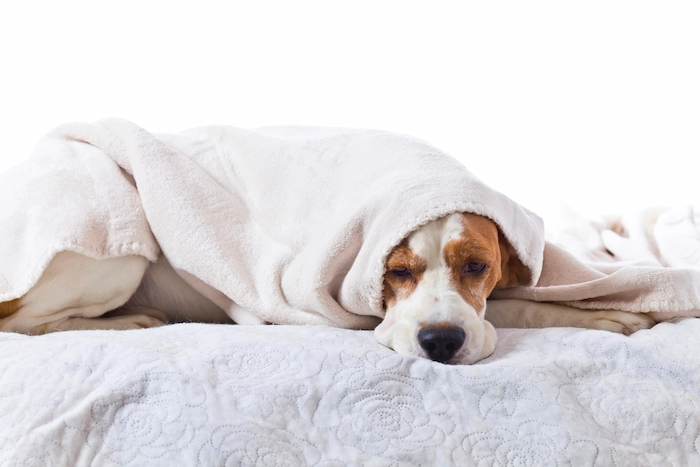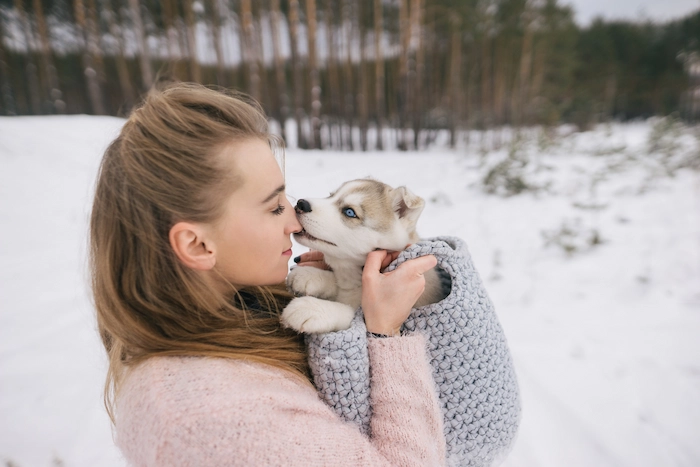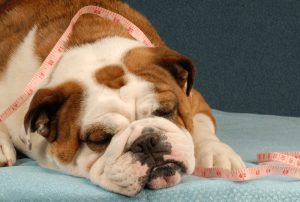
During the winter, severely cold dogs can be uncomfortable and at risk for injury or illnesses — just like humans. You might know that staying inside where it’s warm can help keep your dog healthy, but you can also follow some other tips to care for your pets during the winter months. Learn how to ward off cold symptoms and keep your dog comfortable come snowy weather or blustery days below.
Cold Weather Challenges for Dogs
Cold temperatures, as well as weather such as snow, ice and wind, present unique challenges for various types of pets. Some dog breeds are more adept at surviving and managing in the cold, and they may even enjoy lengthy romps in the snow. Others might become uncomfortable after just a few minutes in brisk weather.
Typically, dogs with longer coats and double coats do best in cold weather. Their winter coats are designed to lock in body temperature, minimize moisture issues and overall keep them cozy and comfortable in the cold. If your pet has a short or thin coat, it’s more likely to struggle to regulate its own body temperature.
Some pets may experience trouble in cold weather despite their breed. Small or young puppies haven’t yet grown the full coat they may need to protect themselves, and their body systems may not be developed enough to stave off illnesses or injuries that can come from cold weather. Senior dogs have similar problems due to health challenges and having weaker overall bodies and immune systems.
Ensure you’re paying attention to your dog’s symptoms and behavior when it’s exposed to cold weather. If you see your pet shivering, display cold-like symptoms such as a runny nose or runny eyes or your dog is just very cold to the touch, consider taking steps to warm it up.
Essential Gear for Cold Weather
If you want to keep your dog warm or avoid having your pet catch a cold, consider gearing it up for outings in cold weather. Pets can wear various clothing to protect them against the weather, just like humans.
Most dogs may try to get out of clothing when you first put it on, but your pet can become more used to these items if you put them on regularly throughout the winter. Some options to consider include:
-
Raincoats. Doggy raincoats can help keep your pet dry during rainy winter walks. Keeping your pet’s coat from getting too soggy can reduce the chance of ice developing in the coat and ensure your dog stays warm. This can reduce symptoms like sneezing, shivering and coughing.
Fleece jackets. On dry cold days, keep your pup comfortable and help it ward off diseases with a well-fitting fleece jacket.
Insulated vest. If your pet is prone to jumping or likes to run unencumbered, keep it warm with a vest that lets it rest and move freely.
Always ensure your dog’s cold-weather gear fits well to reduce the risk of injury. Choosing breathable fabrics such as fleece down can keep your pet warm without leading to sweating or illness-causing moisture being locked near its skin. If you walk your dog at night, choose items that have reflective fabric.
Indoor Care and Comfort
To help your puppy rest comfortably indoors after those icy outings, do the same things you would do to ensure comfort for humans. Draft-proof windows and doors to keep irritating breezes away, and set thermostats to comfortable temperatures to keep your dog cozy.
You might also invest in new bedding for winter. Changing your dog’s bedding each season can reduce allergies and related symptoms, such as coughing, and reduce bacteria that might make your pup sick.
Consider talking to your vet about how to support your dog’s immune system during cold weather. They might recommend an omega-3 supplement to support skin and coat health. They can also help you understand the symptoms of dog colds and viruses so you can react proactively to treat your dog.
Finally, increase your dog’s food intake slightly so it gets more calories. It can take more calories to stay warm during cold weather.
Outdoor Safety Measures
To protect your dog from illnesses and injury when walking or playing outside, consider some of the options below:
- Use booties. Protect pup paws from salt, ice and other irritants on outdoor surfaces by providing them with booties.
- Wipe paws. Wipe your dog’s paws when you come inside to keep them warm and dry.
- Use a Halo Collar 3. Ensure you know where your dog is to keep it safe and near home during extreme weather with the GPS tracking and health monitoring features of the Halo Collar 3.
- Know the symptoms of frostbite and hypothermia. Pale gums, lethargy and shivering are all concerns you should discuss with a veterinarian immediately. You should always check your pet’s extremities for ice crystals as well.

Health Considerations During Winter
Even if you do everything possible to protect your dogs during cold weather, they may catch a cold or other illness from other dogs. Kennel cough, canine flu and the cold virus are all common during winter months. Getting your dog vaccinated can help provide further protection against such issues.
It’s also important to be aware of cold symptoms and signs of other illnesses. If you notice that your dog has persistent coughing, vomiting, diarrhea, fever or other signs of a cold virus or infection, get veterinary treatment right away. You can also talk to your veterinarian about vaccinations at any time.
Fun and Exercise in the Cold
Set an appropriate cold-weather activity schedule for your dog. Active breeds that do well in the cold may enjoy coming along for snowshoeing and dog sledding outings, and if your kids are comfortable bundled up in their own outdoor clothing making a snowman, your bundled pup is probably fine too.
When possible, spend time exercising your dog indoors during the coldest days or extreme weather. Be aware of your dog’s energy level, and consider taking short walks outside throughout the day when possible to reduce exposure to long periods of cold while also allowing it to exercise.
Key Takeaways
Keeping dogs safe during cold months requires a common-sense approach to care. Pay close attention to your dog’s symptoms, seek veterinarian care immediately when there’s a concern and try to have fun with your pup indoors and out throughout the season.






